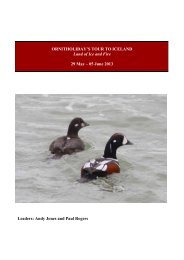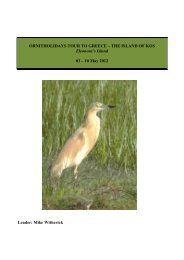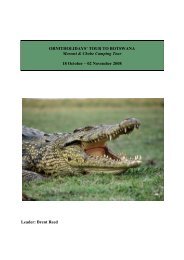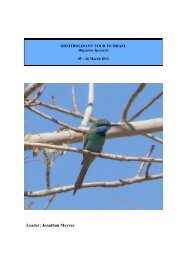Download 2014 Brochure (.pdf) - Ornitholidays
Download 2014 Brochure (.pdf) - Ornitholidays
Download 2014 Brochure (.pdf) - Ornitholidays
You also want an ePaper? Increase the reach of your titles
YUMPU automatically turns print PDFs into web optimized ePapers that Google loves.
Further along the shore, rocky escarpments hold<br />
Klipspringer, while bushes along the tracks are<br />
home to the elusive Peter’s Twin-spot.<br />
Days 7 to 9<br />
We leave Lake Manyara and head towards the<br />
vast natural amphitheatre of the Ngorongoro<br />
Crater. On the way we pass through dry country<br />
where we look for sandgrouse, finch-larks and<br />
Rosy-patched Bush-shrike, before arriving at our<br />
lodge, where we stay for three nights. The Crater<br />
is perhaps one of the most famous game areas<br />
in the world, as well as being one of the biggest<br />
calderas, covering an area of over 250 sq kms<br />
and varying between 600 and 750 metres in<br />
depth. The bottom is mainly grassy plains with<br />
much fresh and brackish standing water in<br />
areas. One large sheet of water, called Lake<br />
Magadi, plays host to Greater and Lesser<br />
Flamingos, waterfowl and shorebirds; the<br />
numbers, which fluctuate from one year to the<br />
next, may run into many thousands of birds.<br />
Animals include Lion, Leopard, Cheetah, Black<br />
Rhinoceros, Zebra, Hartebeest and<br />
Hippopotamus. The Elephants include many<br />
large-tusked bulls that may be over 50 years old.<br />
The bird list is long and includes Ostrich, African<br />
Harrier-Hawk, Verreaux’s Eagle, Black-winged<br />
Plover, Olive Pigeon, Lilac-breasted Roller and<br />
Rosy-breasted Longclaw. Birding around the<br />
camp is not to be ignored and we might well<br />
encounter Hildebrandt’s Francolin, Cape Robin-<br />
Chat, Tropical Boubou and the beautiful Tacazze<br />
and Golden-winged Sunbirds.<br />
Days 10 to 12<br />
This morning we leave Ngorongoro and head for<br />
N’dutu, just on the edge of the Serengeti National<br />
Park. The birds are rewarding and range from<br />
bulky Kori Bustards to tiny Red-throated Tits. We<br />
will be looking for migrating raptors, wheatears<br />
and shrikes amongst the resident Martial Eagles,<br />
Yellow-throated Sandgrouse, Von der Decken’s<br />
Hornbill, White-tailed Lark, Yellow-throated<br />
Longclaw and Magpie Shrike to name but a few.<br />
All the vulture species are represented here –<br />
Rüppell’s, African White-backed, Lappet-faced,<br />
White-headed, Egyptian and Hooded. The<br />
endemic Rufous-tailed Weaver and Grey-breasted<br />
Spurfowl are both easily seen around the lodge.<br />
Days 13 & 14<br />
Later, we head northwards into the Serengeti<br />
National Park and then stay for two nights at the<br />
Serengeti Sopa Lodge. The lodge is set on a<br />
hillside with views across the plains and<br />
woodlands. Hildebrandt’s Starlings are common<br />
in the grounds, and the morning chorus resounds<br />
with calls of hornbills, thrushes and weavers. The<br />
Serengeti National Park covers some 12,000 sq<br />
km of grassy plains in northern Tanzania and<br />
forms a super wildlife sanctuary with the Masai<br />
Mara on the Kenyan side of the border. In our<br />
time here we can only scratch the surface of this<br />
truly remarkable area, but thankfully our local<br />
guides visit the area many times during the year<br />
and have the best places staked out. Many<br />
species are creatures of habit, but with any<br />
wildlife viewing nothing can be guaranteed. At<br />
this time of the year over two million Wildebeest<br />
should be on their migration in this area, and we<br />
can hope to see Lion and Cheetah, as they attend<br />
the moving herds. Being the Serengeti, there will<br />
be many animals present and one of our quarry<br />
species will be the Leopard – perhaps with its tail<br />
hung from a branch like a bell-pull. The Serengeti<br />
is always an adventure, and the photographer<br />
and birder will literally have a field day.<br />
Days 15 & 16<br />
We have some time in the morning to further<br />
sample the delights of the Serengeti, before we<br />
make our way to Serenera where we catch our<br />
return flight to Arusha (thus eliminating a long,<br />
dusty return drive). We transfer from Arusha to Kia<br />
Lodge where we stay overnight. The next day we<br />
transfer to nearby Kilimanjaro Airport for the flight<br />
to London, via Nairobi, arriving the same day.<br />
Golden-winged Sunbird<br />
Outline Itinerary<br />
Day 1 Depart London<br />
Days 2-4 Tarangire National Park<br />
Days 5-6 Lake Manyara<br />
Days 7-9 Ngorongoro<br />
Days 10-12 N’dutu<br />
Days 13-14 Serengeti National Park<br />
Day 15 Kilimanjaro<br />
Day 16 Depart Kilimanjaro<br />
Party Size<br />
Maximum of 12 clients.<br />
Accommodation<br />
Comfortable accommodation in twin/double<br />
and single rooms with private facilities at<br />
camps, lodges, and hotels.<br />
Transport<br />
By land-cruisers, land-rovers and minibuses.<br />
Includes<br />
All flights, meals, accommodation, transport,<br />
entry fees, services of the leaders, airport<br />
taxes and tips.<br />
Gradings<br />
Good/Tented<br />
350<br />
TA N Z A N I A<br />
Warm<br />
Moderate<br />
Special<br />
Relaxed<br />
Excellent<br />
Easy<br />
Scheduled<br />
Burchell’s Zebras fighting in Ngorongoro Crater<br />
Grey-breasted Francolin<br />
To make a booking please call <strong>Ornitholidays</strong> on 01794 519445<br />
49








